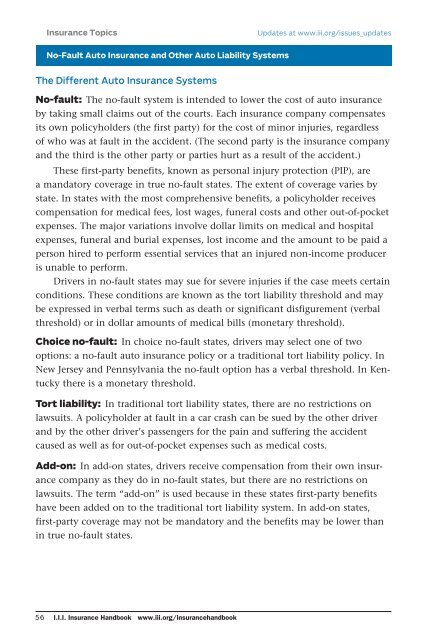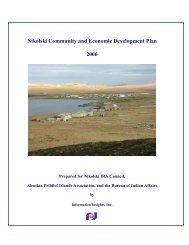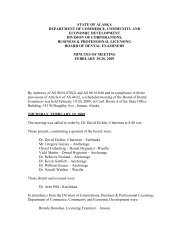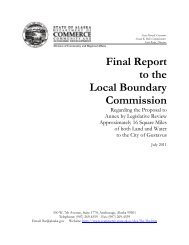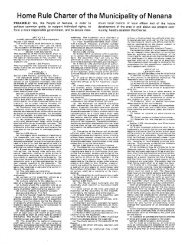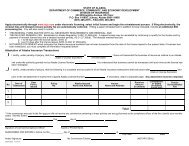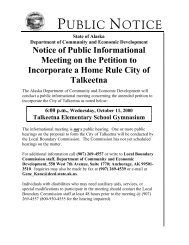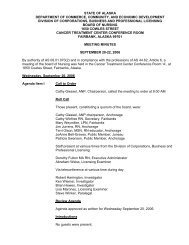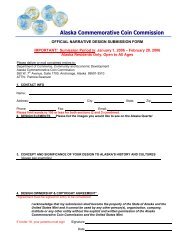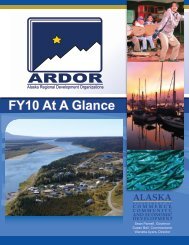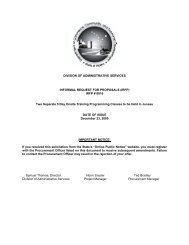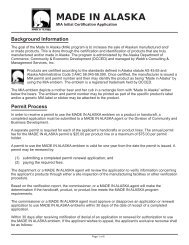Insurance Handbook - Alaska Department of Community and ...
Insurance Handbook - Alaska Department of Community and ...
Insurance Handbook - Alaska Department of Community and ...
Create successful ePaper yourself
Turn your PDF publications into a flip-book with our unique Google optimized e-Paper software.
<strong>Insurance</strong> Topics Updates at www.iii.org/issues_updates<br />
No-Fault Auto <strong>Insurance</strong> Auto <strong>Insurance</strong> <strong>and</strong> Other Auto Liability Systems<br />
The Different Auto <strong>Insurance</strong> Systems<br />
No-fault: The no-fault system is intended to lower the cost <strong>of</strong> auto insurance<br />
by taking small claims out <strong>of</strong> the courts. Each insurance company compensates<br />
its own policyholders (the first party) for the cost <strong>of</strong> minor injuries, regardless<br />
<strong>of</strong> who was at fault in the accident. (The second party is the insurance company<br />
<strong>and</strong> the third is the other party or parties hurt as a result <strong>of</strong> the accident.)<br />
These first-party benefits, known as personal injury protection (PIP), are<br />
a m<strong>and</strong>atory coverage in true no-fault states. The extent <strong>of</strong> coverage varies by<br />
state. In states with the most comprehensive benefits, a policyholder receives<br />
compensation for medical fees, lost wages, funeral costs <strong>and</strong> other out-<strong>of</strong>-pocket<br />
expenses. The major variations involve dollar limits on medical <strong>and</strong> hospital<br />
expenses, funeral <strong>and</strong> burial expenses, lost income <strong>and</strong> the amount to be paid a<br />
person hired to perform essential services that an injured non-income producer<br />
is unable to perform.<br />
Drivers in no-fault states may sue for severe injuries if the case meets certain<br />
conditions. These conditions are known as the tort liability threshold <strong>and</strong> may<br />
be expressed in verbal terms such as death or significant disfigurement (verbal<br />
threshold) or in dollar amounts <strong>of</strong> medical bills (monetary threshold).<br />
Choice no-fault: In choice no-fault states, drivers may select one <strong>of</strong> two<br />
options: a no-fault auto insurance policy or a traditional tort liability policy. In<br />
New Jersey <strong>and</strong> Pennsylvania the no-fault option has a verbal threshold. In Kentucky<br />
there is a monetary threshold.<br />
Tort liability: In traditional tort liability states, there are no restrictions on<br />
lawsuits. A policyholder at fault in a car crash can be sued by the other driver<br />
<strong>and</strong> by the other driver’s passengers for the pain <strong>and</strong> suffering the accident<br />
caused as well as for out-<strong>of</strong>-pocket expenses such as medical costs.<br />
Add-on: In add-on states, drivers receive compensation from their own insurance<br />
company as they do in no-fault states, but there are no restrictions on<br />
lawsuits. The term “add-on” is used because in these states first-party benefits<br />
have been added on to the traditional tort liability system. In add-on states,<br />
first-party coverage may not be m<strong>and</strong>atory <strong>and</strong> the benefits may be lower than<br />
in true no-fault states.<br />
56 I.I.I. <strong>Insurance</strong> <strong>H<strong>and</strong>book</strong> www.iii.org/insuranceh<strong>and</strong>book


